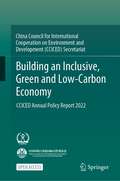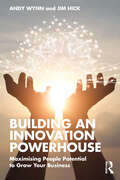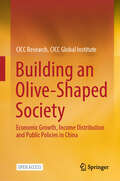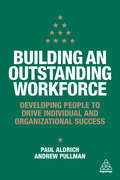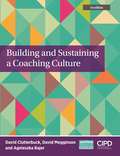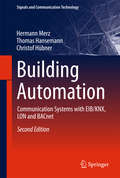- Table View
- List View
Building an Import / Export Business
by Kenneth D. WeissThis bestselling, up-to-date guide shows you how to start your own import/export business, from researching a raw idea to a successful launch to ongoing, profitable business operations. Complete with real-life examples from importers and exporters, it helps you every step of the way, from targeting a market and preparing a business plan to dealing with foreign currencies, shipping procedures, customs requirements, and more. It also shares tips to help you take advantage of NAFTA and other trade pacts, plus online resources to help you start and grow your business.
Building an Inclusive, Green and Low-Carbon Economy: CCICED Annual Policy Report 2022
by CCICEDThis open access book introduces the major environmental green development issues from six major themes carbon neutrality, nature-based solution, watershed management and climate adaptation, BRI green development, sustainable food supply chain, ecosystem-based integrated ocean management focusing on the progress of China’s environment and development policies from 2021 accomplishments. It is based on the research outputs of CCICED in the year of 2021, which marks China’s start point of implementation of its 14th Five-Year Plan when world economy also strived to recover from the pandemic.
Building an Inclusive Organization: Leveraging the Power of a Diverse Workforce
by Stephen Frost Raafi-Karim AlidinaA diverse workforce is a business imperative. Without it, companies are made up of employees who come from the same background and have the same skills and, therefore, the same blind spots. A diverse workforce brings together different strengths, a variety of experiences, a huge breadth of knowledge and myriad creative problem-solving techniques. However, in order to leverage the benefits of this diverse workforce, businesses must be inclusive. Inclusion ensures that employees feel supported, are treated fairly and are therefore happier, more engaged and more productive. This not only improves staff wellbeing but also boosts company performance. Building an Inclusive Organization is a practical guide to creating an environment of real inclusion. It highlights how to remove unconscious bias from company processes including recruitment and selection, how to make the case for diversity and inclusion to all stakeholders and how to embed inclusion into an organization's culture and overall business strategy.Packed with case studies from global organizations including HSBC, UK Civil Service, BBC, KPMG, BAE Systems and Harvard Business School, Building an Inclusive Organization outlines the opportunities inclusion can create and how to leverage the benefits of diversity. There is also guidance and advice on how to measure, review and evaluate inclusion, how to achieve transparency around diversity both inside and outside the organization and how to implement robust processes and policies to foster diversity in organizations of any size from large corporates to SMEs and public sector departments.
Building an Information Security Awareness Program
by Mark B. DesmanIn his latest book, a pre-eminent information security pundit confessed that he was wrong about the solutions to the problem of information security. It's not technology that's the solution, but the human factor-people. But even infosec policies and procedures are insufficient if employees don't know about them, or why they're important, or what ca
Building an Innovation Powerhouse: Maximising People Potential to Grow Your Business
by Andy Wynn Jim HickIn Building an Innovation Powerhouse you will learn how to maximise the potential of people to grow your business. Authors Andy Wynn and Jim Hick dive deep into the most complex aspect of innovation and skilfully deconstruct the multi-dimensional complexities of working with people to reveal the secrets of how to handle the challenges of innovation. Building an Innovation Powerhouse uncovers the inner workings of industry giants, including Boston Consulting Group, Google, Hexcel, Kennametal, DuPont, CeramTec, Novartis, and many more, and explains exactly how these organisations and their leaders have motivated people to create a culture of innovation. A roadmap clearly sets out change in the following:1. Culture – how to guide an organisation to work holistically.2. Teams – how to ensure collaboration is laser-focused on business growth.3. Individuals – what people can do to become more creative and contribute to business success.4. Diversity – how to develop the right mix of skillsets, backgrounds and viewpoints.5. Leadership – what business leaders need to do to ensure that all levels of the business are heading in the right direction and delivering growth. Written with true insight by renowned leaders in their fields and enhanced by valuable case studies and contributions from numerous senior executives who have a real passion for stimulating innovation to drive business growth, this book is essential reading for businesses looking to transform into an innovation powerhouse.
Building an Innovation Powerhouse: Maximising People Potential to Grow Your Business
by Andy Wynn Jim HickIn Building an Innovation Powerhouse you will learn how to maximise the potential of people to grow your business. Authors Andy Wynn and Jim Hick dive deep into the most complex aspect of innovation and skilfully deconstruct the multi-dimensional complexities of working with people to reveal the secrets of how to handle the challenges of innovation. Building an Innovation Powerhouse uncovers the inner workings of industry giants, including Boston Consulting Group, Google, Hexcel, Kennametal, DuPont, CeramTec, Novartis, and many more, and explains exactly how these organisations and their leaders have motivated people to create a culture of innovation. A roadmap clearly sets out change in the following:1. Culture – how to guide an organisation to work holistically.2. Teams – how to ensure collaboration is laser-focused on business growth.3. Individuals – what people can do to become more creative and contribute to business success.4. Diversity – how to develop the right mix of skillsets, backgrounds and viewpoints.5. Leadership – what business leaders need to do to ensure that all levels of the business are heading in the right direction and delivering growth. Written with true insight by renowned leaders in their fields and enhanced by valuable case studies and contributions from numerous senior executives who have a real passion for stimulating innovation to drive business growth, this book is essential reading for businesses looking to transform into an innovation powerhouse.
Building an Innovative Learning Organization: A Framework to Build a Smarter Workforce, Adapt to Change, and Drive Growth
by Russell SarderInstitute a culture of learning to boost organizational performance and agility What makes organizations successful? Today, most successful companies are learning organizations. Building an Innovative Learning Organization shows you how to join their ranks and bring your organization up to the head of the class. This book is a practical, actionable guide on how to boost performance, successfully manage change, and innovate more quickly. Learning organizations are composed of engaged, motivated employees who continually seek improvement, which leads to organizational agility and the ability to innovate ahead of the curve. When you encourage learning at every level, from the intern to the C suite, you gain a more highly skilled workforce with a greater ability to act in any situation. Building an Innovative Learning Organization shows you how to create this culture in your organization, with detailed explanations, practical examples, and step-by-step instructions so you can get started right away. Written by a recognized thought leader in the training industry, this informative and insightful guide is your roadmap to a more effective organization. You will discover how to: Attract, retain, and motivate the best employees Become a more innovative and agile organization Create a culture of continuous self-improvement Encourage learning at all levels and translate it into action Learning and education doesn't end at graduation—it's a lifelong process that keeps you relevant, informed, and better able to achieve your goals. These same benefits apply at the organizational level, making the culture self-sustaining: learning organizations attract top workers, who drive the organization forward, which attracts more top workers. If you want the best people, you have to be their best option. Building an Innovative Learning Organization gives you a blueprint for building a culture of learning, for a stronger, more robust organization.
Building an Innovative Learning Organization: A Framework to Build a Smarter Workforce, Adapt to Change, and Drive Growth
by Russell SarderInstitute a culture of learning to boost organizational performance and agility What makes organizations successful? Today, most successful companies are learning organizations. Building an Innovative Learning Organization shows you how to join their ranks and bring your organization up to the head of the class. This book is a practical, actionable guide on how to boost performance, successfully manage change, and innovate more quickly. Learning organizations are composed of engaged, motivated employees who continually seek improvement, which leads to organizational agility and the ability to innovate ahead of the curve. When you encourage learning at every level, from the intern to the C suite, you gain a more highly skilled workforce with a greater ability to act in any situation. Building an Innovative Learning Organization shows you how to create this culture in your organization, with detailed explanations, practical examples, and step-by-step instructions so you can get started right away. Written by a recognized thought leader in the training industry, this informative and insightful guide is your roadmap to a more effective organization. You will discover how to: Attract, retain, and motivate the best employees Become a more innovative and agile organization Create a culture of continuous self-improvement Encourage learning at all levels and translate it into action Learning and education doesn't end at graduation—it's a lifelong process that keeps you relevant, informed, and better able to achieve your goals. These same benefits apply at the organizational level, making the culture self-sustaining: learning organizations attract top workers, who drive the organization forward, which attracts more top workers. If you want the best people, you have to be their best option. Building an Innovative Learning Organization gives you a blueprint for building a culture of learning, for a stronger, more robust organization.
Building an Olive-Shaped Society: Economic Growth, Income Distribution and Public Policies in China
by CICC Research, CICC Global InstituteThis open access book offers a comprehensive analysis of China’s way of economic development balancing between efficiency and equity, striving to investigate existing challenges and to discuss the role of fiscal policies and philanthropy to mitigate social inequality. The book analyzes the current overall state and challenges of China's income and wealth distribution and describes the social inequality in specific fields such as labor market, housing markets, education, public health, infrastructure building and carbon emission. This book also explores the implications of long-run trends of macro-asset pricing. The book is both academically rigorous and readable. This valuable reference will attract readers in economics, public finance and social policy who seek to better understand China’s path of combating social inequality.
Building an Organizational Coaching Culture: Creating Effective Environments for Growth and Success in Organizations
by Behnam Bakhshandeh William J. RothwellBuilding an Organizational Coaching Culture is a comprehensive collection of expert pieces examining the models, methods and approaches to establish a sustainable coaching culture in organizations. The different perspectives highlight how coaching skills can be used to positively influence workforces in the areas of critical thinking, communication, creativity and collaboration, and how they can have a direct impact on performance and productivity. Contributors from a range of professional contexts include theoretical grounding and application to practice across topics including talent management, implementing coaching programs, developing leadership qualities, using positive psychology, self-evaluations, and standards and ethics. This is a great resource for both students and professionals wanting to engage more with coaching cultures.
Building an Organizational Coaching Culture: Creating Effective Environments for Growth and Success in Organizations
Building an Organizational Coaching Culture is a comprehensive collection of expert pieces examining the models, methods and approaches to establish a sustainable coaching culture in organizations. The different perspectives highlight how coaching skills can be used to positively influence workforces in the areas of critical thinking, communication, creativity and collaboration, and how they can have a direct impact on performance and productivity. Contributors from a range of professional contexts include theoretical grounding and application to practice across topics including talent management, implementing coaching programs, developing leadership qualities, using positive psychology, self-evaluations, and standards and ethics. This is a great resource for both students and professionals wanting to engage more with coaching cultures.
Building an Outstanding Workforce: Developing People to Drive Individual and Organizational Success
by Paul Aldrich Andrew PullmanIn an increasingly volatile, uncertain, complex and ambiguous world, achieving sustainable competitive advantage has never been more important, or more difficult. However, the key challenge for CEOs, senior executives and HR professionals is how to unlock the potential of their people, building a culture that allows employees to perform to the best of their abilities and effectively attract, engage, develop and retain the staff needed for sustainable business success. Building an Outstanding Workforce is a must-have guide for all professionals looking to leverage the potential of their people and maximise value for all stakeholders. Including evolutionary psychology, neuroscience and personality psychology, this book takes an evidence-based approach to people management. With practical guidance, expert advice and case studies from companies including Alibaba, Barclays Banking Group, Patagonia, Tata Group and Quantas, Building an Outstanding Workforce covers all the key issues including how to tailor people management to address the motivations of different generations, the impact of emergent technology on the workforce, the shift in the skills employees now need to learn and develop and how to handle the new challenges of remote and flexible working and the gig economy. There is also essential coverage of strategic workforce planning, people risk, people analytics, human capital reporting, the employer brand and employee value proposition and the benefits of embracing diversity and inclusion, well-being and other aspects of corporate and social responsibility. It presents a new people-focused framework for people management that redefines the structure, roles and responsibilities of human resource management and addresses the problems of role ambiguity and conflict associated with HR to deliver people management that everyone needs and deserves.
Building an Outstanding Workforce: Developing People to Drive Individual and Organizational Success
by Paul Aldrich Andrew PullmanIn an increasingly volatile, uncertain, complex and ambiguous world, achieving sustainable competitive advantage has never been more important, or more difficult. However, the key challenge for CEOs, senior executives and HR professionals is how to unlock the potential of their people, building a culture that allows employees to perform to the best of their abilities and effectively attract, engage, develop and retain the staff needed for sustainable business success. Building an Outstanding Workforce is a must-have guide for all professionals looking to leverage the potential of their people and maximise value for all stakeholders. Including evolutionary psychology, neuroscience and personality psychology, this book takes an evidence-based approach to people management. With practical guidance, expert advice and case studies from companies including Alibaba, Barclays Banking Group, Patagonia, Tata Group and Quantas, Building an Outstanding Workforce covers all the key issues including how to tailor people management to address the motivations of different generations, the impact of emergent technology on the workforce, the shift in the skills employees now need to learn and develop and how to handle the new challenges of remote and flexible working and the gig economy. There is also essential coverage of strategic workforce planning, people risk, people analytics, human capital reporting, the employer brand and employee value proposition and the benefits of embracing diversity and inclusion, well-being and other aspects of corporate and social responsibility. It presents a new people-focused framework for people management that redefines the structure, roles and responsibilities of human resource management and addresses the problems of role ambiguity and conflict associated with HR to deliver people management that everyone needs and deserves.
Building and Implementing a Security Certification and Accreditation Program: OFFICIAL (ISC)2 GUIDE to the CAPcm CBK ((isc)2 Press Ser.)
by Patrick D. Howard� Building and Implementing a Security Certification and Accreditation Program: Official (ISC)2 Guide to the CAP CBK demonstrates the practicality and effectiveness of certification and accreditation (C&A) as a risk management methodology for IT systems in both public and private organizations. It provides security professiona
Building and Improving Health Literacy in the ‘New Normal’ of Health Care: Frameworks and Actions (European Health Management in Transition)
by Federico Lega Pia KreutzerResearch shows that low health literacy (HL) is linked to poorer mental and physical health, increased health inequalities and less cost-effective health care systems. HL results in Europe indicate that almost 50% of the respondents in eight member states of the European Union displayed limited HL. Reasons for this range from demographic to socioeconomic, health-related and economic relationships that need to be explored to understand why policymakers and health care managers should care about health literacy. Building and Improving Health Literacy in the 'New Normal' of Health Care explores how health literacy is assessed and measured, both systematically in scientific studies as well as "ad hoc" by medical professionals. The latter shapes how medical staff interacts with patients and therefore is a crucial aspect of patients' understanding. Exemplary data of health literacy results are explained, with a focus on where to obtain health information and how it is communicated, leading on to a discussion exploring how innovations can remedy these potential problems. Building and Improving Health Literacy in the 'New Normal' of Health Care identifies desirable paths of action to improve health literacy amongst patients, focusing on new technologies that could facilitate reducing health disparities. It is an essential read for policymakers and health care managers.
Building and Improving Health Literacy in the ‘New Normal’ of Health Care: Frameworks and Actions (European Health Management in Transition)
by Federico Lega Pia KreutzerResearch shows that low health literacy (HL) is linked to poorer mental and physical health, increased health inequalities and less cost-effective health care systems. HL results in Europe indicate that almost 50% of the respondents in eight member states of the European Union displayed limited HL. Reasons for this range from demographic to socioeconomic, health-related and economic relationships that need to be explored to understand why policymakers and health care managers should care about health literacy. Building and Improving Health Literacy in the 'New Normal' of Health Care explores how health literacy is assessed and measured, both systematically in scientific studies as well as "ad hoc" by medical professionals. The latter shapes how medical staff interacts with patients and therefore is a crucial aspect of patients' understanding. Exemplary data of health literacy results are explained, with a focus on where to obtain health information and how it is communicated, leading on to a discussion exploring how innovations can remedy these potential problems. Building and Improving Health Literacy in the 'New Normal' of Health Care identifies desirable paths of action to improve health literacy amongst patients, focusing on new technologies that could facilitate reducing health disparities. It is an essential read for policymakers and health care managers.
Building and Managing High-Performance Distributed Teams: Navigating the Future of Work
by Alberto S. Silveira Jr.The age of the distributed team is upon us. Teams can now operate and collaborate from locations other than a central office, and events surrounding the 2020 COVID pandemic have thrown its practicality into sharp relief. Managing a team whose members are distributed across several locations requires a different mindset and will remain a must-have for all areas of business from this point forward.Building and Managing High-Performance Distributed Teams explains what the distributed teams concept means to the future of your company. Author Alberto S. Silveira Jr. leverages his industry knowledge to explore why the high-performance distributed team model is vital to the future of business, and explains how to build and maintain one through times of change. You will learn to differentiate between distributed teams, remote work, offshoring, and what each means in a modern context. Silveira also weaves in stories from his other life as a boater and sailor, using analogies and lessons gained from humankind’s thousands of years of maritime adventure to illustrate the value of well-managed teams, and to also convey the importance of life-work balance in today’s working world.The book analyzes team management strategies from some of the great successes and failures in recent years so that you can learn from the experiences of others. Building and Managing High-Performance Distributed Teams is your definitive guide for building a dynamic distributed team, using collaboration technology to attract and engage the most important element of any business—your people. Whether you are a department head, a business owner, or a team leader, this book presents the no-nonsense knowledge you need now to chart your course for success. What You Will LearnUnderstand what the new era of connected business means, and the role distributed teams will play.Differentiate between distributed teams, remote work, nearshore, and offshoring, and what each means to modern business.Discover the true heart of a high-performance distributed team (hint: it’s not the technology).Find out what the era of distributed teams means to existing infrastructure.Uncover what we can learn about team management from some of the great successes and failures of recent years.Appreciate the techniques honed by seafarers, pilots, and software designers combined to create a successful project plan for team management and company navigation.Comprehend the effective simplicity of the “power of three” in building successful teams.Apply proven techniques of measurement and metrics without leaving the human factor behind to improve team morale and productivity. Who This Book Is ForTeam leaders or officers of small-ish companies, with populations in the tens through to the mid-hundreds. It’s also for managers of somewhat autonomous departments within larger companies, and for everyone else in the boat because everyone in a company ultimately needs to know what being in a distributed team is all about.
Building and Solving Mathematical Programming Models: 50 Practical Examples (International Series in Operations Research & Management Science #329)
by José Manuel García SánchezThis book presents the construction and resolution of 50 practical optimization problems and covers an exceptionally wide range, including games-associated problems (Unblock Me, Sudokus), logistical problems, and problems concerning plant distribution, production, operations scheduling, management and resource allocation. The problems are divided into 5 difficulty levels. Problems in the first few levels are focused on learning the model construction methodology, while those in the last level include complex optimization environments. For each problem solution, the specific steps are illustrated, promoting reader comprehension. In addition, all the models are implemented in an optimization library, LINGO, their solutions have been analyzed and their correct construction has been verified. The book also includes a simple guide to implementing models in LINGO in a straightforward manner and in any input data format (text files, spreadsheets or databases). As an ideal companion to the author’s previously published work Modelling in Mathematical Programming, the book is intended as a basic tool for students of operations research, and for researchers in any advanced area involving mathematical programming.
Building and Sustaining a Coaching Culture
by Agnieszka Bajer David Clutterbuck David MegginsonBuilding and Sustaining a Coaching Culture is the ideal book for everyone who is passionate about coaching and who has an interest in creating an environment that supports learning and growth. Easy to navigate and logically structured, topics include the current understanding of coaching culture in organisations, coaching and mentoring culture strategy, making effective use of external coaches, formal and informal mentoring, developing and supporting internal coaches and mentors, team coaching, cross-cultural marketing coaching and cross-cultural issues. This edition of Building and Sustaining a Coaching Culture is a fully revised version of the seminal book Making Coaching Work: Creating a Coaching Culture. It analyses what has changed in the field of coaching culture and provides update on new knowledge and experience. A wide variety of international case studies and engaging tools such as chapter overviews, templates, and reflective questions will take you clearly through the development and implementation of a successful and integrated training culture. Whether you are an HR Manager looking to maximise the positive impact of coaching in your organisation, a business leader wanting to facilitate growth, or a consultant or coach seeking to place your work in the relevant organisational context, you will be shown how to implement an effective coaching and mentoring strategy that meets your needs.
Building and Sustaining a Coaching Culture
by Agnieszka Bajer David Clutterbuck David MegginsonBuilding and Sustaining a Coaching Culture is the ideal book for everyone who is passionate about coaching and who has an interest in creating an environment that supports learning and growth. Easy to navigate and logically structured, topics include the current understanding of coaching culture in organisations, coaching and mentoring culture strategy, making effective use of external coaches, formal and informal mentoring, developing and supporting internal coaches and mentors, team coaching, cross-cultural marketing coaching and cross-cultural issues. This edition of Building and Sustaining a Coaching Culture is a fully revised version of the seminal book Making Coaching Work: Creating a Coaching Culture. It analyses what has changed in the field of coaching culture and provides update on new knowledge and experience. A wide variety of international case studies and engaging tools such as chapter overviews, templates, and reflective questions will take you clearly through the development and implementation of a successful and integrated training culture. Whether you are an HR Manager looking to maximise the positive impact of coaching in your organisation, a business leader wanting to facilitate growth, or a consultant or coach seeking to place your work in the relevant organisational context, you will be shown how to implement an effective coaching and mentoring strategy that meets your needs.
Building Anti-Fragile Organisations: Risk, Opportunity and Governance in a Turbulent World
by Tony BendellEvery day human organisations fail. Building Anti-Fragile Organisations explores a powerful alternative framework for risk in the design and management of human systems. Anti-Fragility is a new way of thinking about mitigating risk that builds on earlier work on the characteristics of biological systems that, being more than just robust, actually improve their resilience through being stressed. Professor Bendell explains how applying this concept to the development and management of organisations, services and products, allows us to identify the characteristics that will not only mitigate against the realisation of hazards, but enable growth in protection, strength and anti-fragility over time. In this context, anti-fragility also encompasses flexibility, agility and the exploitation of opportunities. At the organisational level, anti-fragility (or its absence) is determined by the organisational strategy, structure and systems, its people, relationships and culture. The book focuses on establishing the Anti-Fragile concept of the firm, and explores its application in private and public sector organisations of all types. It identifies characteristics relevant to survival in a turbulent world, and how our approaches to risk and governance need to change in order to create and manage anti-fragile organisations. It provides practical insight into the concept of Anti-Fragility and its deployment within human organisations of all types, and give readers the opportunity to start to make sense to applying the concepts within their own worlds.
Building Anti-Fragile Organisations: Risk, Opportunity and Governance in a Turbulent World
by Tony BendellEvery day human organisations fail. Building Anti-Fragile Organisations explores a powerful alternative framework for risk in the design and management of human systems. Anti-Fragility is a new way of thinking about mitigating risk that builds on earlier work on the characteristics of biological systems that, being more than just robust, actually improve their resilience through being stressed. Professor Bendell explains how applying this concept to the development and management of organisations, services and products, allows us to identify the characteristics that will not only mitigate against the realisation of hazards, but enable growth in protection, strength and anti-fragility over time. In this context, anti-fragility also encompasses flexibility, agility and the exploitation of opportunities. At the organisational level, anti-fragility (or its absence) is determined by the organisational strategy, structure and systems, its people, relationships and culture. The book focuses on establishing the Anti-Fragile concept of the firm, and explores its application in private and public sector organisations of all types. It identifies characteristics relevant to survival in a turbulent world, and how our approaches to risk and governance need to change in order to create and manage anti-fragile organisations. It provides practical insight into the concept of Anti-Fragility and its deployment within human organisations of all types, and give readers the opportunity to start to make sense to applying the concepts within their own worlds.
Building Automated Trading Systems: With an Introduction to Visual C++.NET 2005 (Financial Market Technology)
by Benjamin Van VlietOver the next few years, the proprietary trading and hedge fund industries will migrate largely to automated trade selection and execution systems. Indeed, this is already happening. While several finance books provide C++ code for pricing derivatives and performing numerical calculations, none approaches the topic from a system design perspective. This book will be divided into two sections—programming techniques and automated trading system ( ATS ) technology—and teach financial system design and development from the absolute ground up using Microsoft Visual C++.NET 2005. MS Visual C++.NET 2005 has been chosen as the implementation language primarily because most trading firms and large banks have developed and continue to develop their proprietary algorithms in ISO C++ and Visual C++.NET provides the greatest flexibility for incorporating these legacy algorithms into working systems. Furthermore, the .NET Framework and development environment provide the best libraries and tools for rapid development of trading systems.The first section of the book explains Visual C++.NET 2005 in detail and focuses on the required programming knowledge for automated trading system development, including object oriented design, delegates and events, enumerations, random number generation, timing and timer objects, and data management with STL.NET and .NET collections. Furthermore, since most legacy code and modeling code in the financial markets is done in ISO C++, this book looks in depth at several advanced topics relating to managed/unmanaged/COM memory management and interoperability. Further, this book provides dozens of examples illustrating the use of database connectivity with ADO.NET and an extensive treatment of SQL and FIX and XML/FIXML. Advanced programming topics such as threading, sockets, as well as using C++.NET to connect to Excel are also discussed at length and supported by examples.The second section of the book explains technological concerns and design concepts for automated trading systems. Specifically, chapters are devoted to handling real-time data feeds, managing orders in the exchange order book, position selection, and risk management. A .dll is included in the book that will emulate connection to a widely used industry API ( Trading Technologies, Inc.’s XTAPI ) and provide ways to test position and order management algorithms. Design patterns are presented for market taking systems based upon technical analysis as well as for market making systems using intermarket spreads. As all of the chapters revolve around computer programming for financial engineering and trading system development, this book will educate traders, financial engineers, quantitative analysts, students of quantitative finance and even experienced programmers on technological issues that revolve around development of financial applications in a Microsoft environment and the construction and implementation of real-time trading systems and tools.* Teaches financial system design and development from the ground up using Microsoft Visual C++.NET 2005.* Provides dozens of examples illustrating the programming approaches in the book* Chapters are supported by screenshots, equations, sample Excel spreadsheets, and programming code
Building Automation: Communication systems with EIB/KNX, LON and BACnet (Signals and Communication Technology)
by James Backer Hermann Merz Viktoriya Moser Thomas Hansemann Leena Greefe Christof HübnerThis book offers all important industrial communication systems for buildings in one single book! It stimulates a basic understanding of network and bus systems for the automation of buildings. After an introduction to EIB/KNX, LON und BACnet technologies, the authors illustrate how these systems can be utilized for specific applications, like air conditioning or illumination. This book assumes only a basic knowledge of mathematics and thanks to its simple explanations and many examples is ideal for students and professional engineers who require practical solutions.Numerous practical examples explain basic concepts of industrial communication technology as well as the procedure for the transmission of digital data. All chapters have been thoroughly revised for the 2nd edition and the book includes the latest technical developments and standards.
Building Better Arts Facilities: Lessons from a U.S. National Study. (Routledge Research in the Creative and Cultural Industries)
by Joanna Woronkowicz D. Carroll Joynes Norman BradburnAt the turn of the 21st century, a significant boom in the construction of cultural buildings took saw the creation of hundreds of performing arts centers, theaters, and museums. After these buildings were completed, however, many of these cultural organizations struggled to survive, or, alternatively, drifted off mission as the construction project forced monetary or other considerations to be prioritized. Building Better Arts Facilities: Lessons from a U.S. National Study examines the ways in which organizations planned and managed building projects during this boom, and investigates organizational operations after projects were completed. By integrating quantitative data with case-study evidence, the authors identify the differences between the ways some organizations were able to successfully meet the challenges of a large construction project and others that were not. With empirical evidence and analysis, this book highlights better practices for managing and leading cultural building ventures. Readers of this book – be they arts managers, politicians, board members, city planners, foundation executives, or philanthropists – will find that book provides valuable perspective and insight about building cultural facilities, and that reading it will serve to make building projects go more smoothly in the future.

